
About UsThe Numismatic Bibliomania Society is a non-profit organization devoted to the study and enjoyment of numismatic literature. For more information please see our web site at coinbooks.org SubscriptionsThose wishing to become new E-Sylum subscribers (or wishing to Unsubscribe) can go to the following web page link MembershipThere is a membership application available on the web site Membership Application To join, print the application and return it with your check to the address printed on the application. Membership is only $20 to addresses in the U.S., $25 for First Class mail, and $30 elsewhere. For those without web access, write to: David M. Sundman, Treasurer
AsylumFor Asylum mailing address changes and other membership questions, contact David at this email address: dsundman@LittletonCoin.com SubmissionsTo submit items for publication in The E-Sylum, just Reply to this message, or write to the Editor at this address: whomren@gmail.com BUY THE BOOK BEFORE THE COIN |
- WAYNE'S WORDS: THE E-SYLUM FEBRUARY 8, 2015
- ASYLUM OCTOBER-DECEMBER 2014 ISSUE PUBLISHED
- KOLBE & FANNING ANNOUNCE ONLINE-ONLY SALES
- BALDWIN'S OFFER NUMISMATIC LITERATURE
- NEW BOOK: THE D. BRENT POGUE RARE COIN CABINET
- MORE ON MARGO RUSSELL
- JOHN H. BURNS ESTATE SETTLED
- NOTES FROM E-SYLUM READERS: FEBRUARY 8, 2015
- MORE ON ENCASED COINS
- THE FIVE SISTERS BORN 1854 BY DAVID H. COHEN
- FOOD STAMP CHANGE TOKEN RESEARCH UPDATE
- AUTHOR SEEKS RECOLLECTIONS OF THE FRIEDBERGS
- ANA PLANS TOUR OF PROPOSED U.S. MINT SITE AT THE DALLES
- THE ROYAL MINT'S SMALLEST AND LARGEST COINS GO ON TRIAL
- FOLLOW-UP ON SEARCH FOR CURRENT WORLD COINS
- 2015 MEDAL COLLECTORS OF AMERICA MEDAL
- HARVEY STACK ON THE COLLECTIONS OF REED HAWN
- PENNIES CHANGED THE COLOR OF A HOT SPRING
- CUBA UNVEILS LARGE DENOMINATION BANKNOTES
- TEXAS MAN PAYS TAXES IN FOLDED DOLLAR BILLS
- FEATURED WEB PAGE: THE BLACK CABINET
Click here to access the complete archive
To comment or submit articles, reply to whomren@gmail.com
WAYNE'S WORDS: THE E-SYLUM FEBRUARY 8, 2015

New subscribers this week include: Sara Soller. Welcome aboard! We now have 1,818 subscribers.
This week we open with the latest issue of our print journal The Asylum, an announcement from Kolbe & Fanning, some more book selections from Baldwin's, and one new book.
Other topics include Margo Russell, John Burns, Reed Hawn, Encased Coins, the Trial of the Pyx, and Cuba's new banknotes.
To learn more about the Black Cabinet, Spintrae, Copper-Plated 1943 Steel Cents, the Queen’s Remembrancer and the Five Sisters Born 1854, read on. Have a great week, everyone!
Wayne Homren
Editor, The E-Sylum
ASYLUM OCTOBER-DECEMBER 2014 ISSUE PUBLISHED
Editor David Yoon writes:
Another issue of The Asylum is at the printers. Here are the contents:
 Eleonora
Giampiccolo - A Brief History of the Medagliere of the Vatican Library
Eleonora
Giampiccolo - A Brief History of the Medagliere of the Vatican Library- Elizabeth Hahn Benge - An Interview with Mark Santangelo at George Washington’s Mount Vernon
- David Yoon - Publications Associated with the International Medallic Exhibition of 1910
- David F. Fanning - Off the Shelf: The Sales of J. M. Henderson
- David Hill - From the ANS Library
For a membership application form, see:
www.coinbooks.org/about/NBS_Membership_Form_2014.pdf
KOLBE & FANNING ANNOUNCE ONLINE-ONLY SALES
Kolbe & Fanning Numismatic Booksellers have announced that beginning on February 28, they will begin to offer a series of online-only book auctions through their online bidding portal at auction.numislit.com.
These new sales will be held in addition to our regularly held public and mail-bid sales with printed catalogues. Our plan is to hold these online sales regularly but to keep them small (300 to 400 lots). They will be held using the same online bidding software we’ve been using for our recent auctions, utilizing the platform developed by iCollector.com. If you’ve participated through the internet in any of our sales since last May, you’ll know what to expect. If not, now is a good time to set up an iCollector account and see for yourself how easy it is.
Our first online-only sale will be posted to our website in the next week. We’ll send a separate announcement regarding it at that time. It will close on Saturday, Feb. 28 and be held as a real-time online auction. There will be no printed catalogue. While clients are encouraged to participate for themselves online, those unable to do so are certainly allowed to continue bidding in the traditional ways, as long as all absentee bids are received before the day of the sale. A PDF will be posted to the regular www.numislit.com site for ease of reference.
We hope our clients will join us in welcoming this additional way of buying and selling numismatic literature.
More details to come!
David F. Fanning, Ph.D.
Kolbe & Fanning Numismatic Booksellers LLC
141 W. Johnstown Rd.
Gahanna, OH 43230
(614) 414-0855
Cell (614) 256-8915
Fax (614) 414-0860
df@numislit.com
www.numislit.com
Members ANA, ANS, IAPN
BALDWIN'S OFFER NUMISMATIC LITERATURE
The History & Coinage of the Parthians
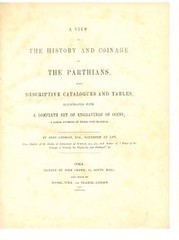 Lindsay, J. A View of the History and Coinage of the Parthians with Descriptive catalogues and
Tables, Illustrated with a Complete Set of Engravings of Coins, a Large number of them Unpublished. Cork, 1852. Quarto, pp. vii, 250, (2), 12 colour
washed engraved plates. First free endpaper heavily creased but with a presentation inscription from the author to James Cove Jones dated June 7th
1853. Bound in olive boards and tanned linen spine. Worn and rubbed, backstrip chipped with the front board detached. Contents heavily foxed.
Lindsay, J. A View of the History and Coinage of the Parthians with Descriptive catalogues and
Tables, Illustrated with a Complete Set of Engravings of Coins, a Large number of them Unpublished. Cork, 1852. Quarto, pp. vii, 250, (2), 12 colour
washed engraved plates. First free endpaper heavily creased but with a presentation inscription from the author to James Cove Jones dated June 7th
1853. Bound in olive boards and tanned linen spine. Worn and rubbed, backstrip chipped with the front board detached. Contents heavily foxed.
For more information, or to order, see:
The History & Coinage of the Parthians
(www.baldwin.co.uk/a-view-of-the-history-and-coinage-of-the-parthians.html)
Le Tessere Erotiche Romane
 Simonetta, B. & Riva, R. Le Tessere Erotiche Romane (Spintrae). Lugano, 1981. Small quarto, pp. 44, 7 b/w plates. Text in Italian but with
summaries in French, German and English. Casebound. Rarely seen. Inscription on title page, slight damp staining to endpapers else fine.
Simonetta, B. & Riva, R. Le Tessere Erotiche Romane (Spintrae). Lugano, 1981. Small quarto, pp. 44, 7 b/w plates. Text in Italian but with
summaries in French, German and English. Casebound. Rarely seen. Inscription on title page, slight damp staining to endpapers else fine.
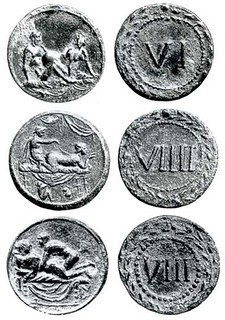 For more information,
or to order, see:
For more information,
or to order, see:
Le Tessere Erotiche Romane
(www.baldwin.co.uk/le-tessere-erotiche-romane.html)
To read the earlier E-Sylum article, see:
BOOK ON SPINTRIAE: LE TESSERE EROTICHE ROMANE
(www.coinbooks.org/esylum_v15n11a06.html)
To view the complete Baldwin's book catalog, see: www.baldwin.co.uk/catalog/category/view/id/321

NEW BOOK: THE D. BRENT POGUE RARE COIN CABINET
 Hot Off the Press: Treasures From The D. Brent Pogue Rare Coin Cabinet – A National Legacy
Hot Off the Press: Treasures From The D. Brent Pogue Rare Coin Cabinet – A National Legacy
Q. David Bowers has created another masterpiece. This book tells the story of 100 of the rarest and most interesting copper, silver, and gold coins in the D. Brent Pogue Collection—how they were minted, who owned them in the past, and the factors that have made them the rarest of the rare, the finest of the fine. Written in Dave's highly readable, indeed absorbing style, we guarantee this will be a favorite. Get set for a great experience.
What You Will Get
The book is extensively illustrated in color, and is deluxe hardbound with gold-foil-imprinted cover, and printed on high-quality paper stock.
Special value: The book will list for $39.95 plus postage, although normally a limited edition of a comparable book would be $60 or more.
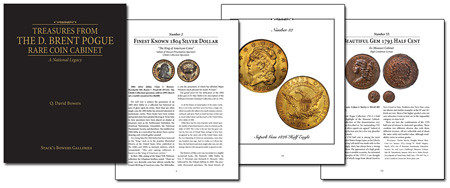
To order, see:
Treasures from the D. Brent Pogue Rare Coin
Cabinet-A National Legacy (www.stacksbowers.com/SBGDirect/BuyCoins/PD/tabid/
236/ProductID/864753/Default.aspx)
MORE ON MARGO RUSSELL
Corrections on Margo Russell Coverage
Former Coin World editor Beth Deisher offered the details of be predecessor Margo Russell's birth and death dates. She was born Oct. 17,
1919, and died Monday, Jan. 26, 2015. I got the math wrong in writing the headline for last week's E-Sylum article; we'll correct our
archive. Thanks!
David Ganz Remembers Margo Russell
Margo Russell, who died last week at age 95, served as Coin World’s editor for 23 of its first 25 years. I knew her well, and had extensive,
professional interactions with her, from about 1970 until she retired in 1985, around the same time that I decided to run for the American Numismatic
Association (ANA) Board. We worked on a number of items of mutual interest, particularly in Washington between 1970 and 1973, while I was in college
attending the School of Foreign Service at Georgetown University.
In those days, congressional hearings on coin matters would usually be scheduled for Thursdays at 930a.m. My job was to take notes and call the story in to Coin World News Editor Ron Keysor in this pre-internet era – a 16 to 20 paragraph story (four typewriter lines to the paragraph) that was tight on deadline.
Margo always had the final word, but at 11:30 sharp – whether or not the hearing was over– my job was to call Keysor and dictate the story so that it was complete by 11:45; the paper had to still be plated and on the press at 12 noon. There was never time to type it before hand, but clear dictation and an occasional editorial query gave me a lifetime appreciation for precision in speech.
For some of the years (1969-1973), I was the Washington correspondent for Krause Publications (Numismatic News– that’s right, I was Burnett Anderson before he was) – and by 1974 (my first year in law school), I was a stringer writing for Coin World as well as Numismatic News and COINage Magazine – all at the same time. I freelanced More than 300 articles That Year, using my column “Under the Glass” which had been running weekly in Numismatic News since 1969, “Insider’s Report” for COINAge together with feature articles under my own name and several pseudonyms (Charles Logan and Brendan Thorpe among them). There was also “Coin Market Perspective” for Coins Magazine, and freelanced stories – most of them page one items– for Coin World, to which I also added a weekly (and later monthly) column, “Law & Collectibles” [Krause was proprietary about them using “Under the Glass”, which I started writing in 1965).
Mostly working with Coin World’s editorial staff, and eventually the news editor on a regular basis, Margo and I occasionally spoke by phone or saw each other at events. She frequently testified before the Senate or House Banking subcommittees that dealt with coinage, and, starting in 1974, so did I – but she testified and wrote about the event, and so did I (for Numismatic News and COINage generally). Usually, though we never compared our testimony beforehand, we were on the same page.
It is fair to say that she viewed the two of us as competitors – in that respect, we could never be really close friends – though we had a friendly competition despite three decades age difference). She knew she was the better editor and reporter, and tolerated my occasional scoop as well as friendly competition.
She was generous in making sure that I was well fed (often her treat) and that I was able to attend functions of the Numismatic Literary Guild as well as press conferences.; she did the same for Paul Whitnah, a lifelong friend of mine (who was two years older than me).
But she was an aggressive newspaper editor, reporter, and – she herself was an occasional government official who testified before Congress, was vice chair of the Bicentennial Commission’s Coins & Medals Advisory Panel, and a well-known person to run interference if she thought the ANA ought to take a position that was diametrically opposed to her opinion. (She often suggested names to the ANA board for medals of merit and other awards).
I look back at my notes to the bicentennial period and think, with hindsight, Margo was under-rated. I know that she pushed Mary Brooks on the issue of a gold bicentennial coin and medal (the medal was produced) and felt that the use of the 50 cent piece and dollar just wasn’t appropriate for the 200th anniversary of American independence.
The minutes of the Coins & Medals Advisory Panel in or around 1972-3 show how she operated behind the scenes, first advocating a change across the board of US coinage for the bicentennnial and secondly, a gold medal for the event and, possibly a gold coin. (Though not a collector herself, she understood that collectors want to collect and that in and of itself this was sufficient basis to break precedent and have a gold coin issue,
My book 14 Bits which appeared in 1976 and later serialized in The Numismatist, briefly recalls some of her positions:
"It has been recommended by this Panel that there be a commemorative coin," commented Dr. Lynn Carroll, a staff member of the ARBC, but in what turned out to be a characteristic understatement, he added "we don't have any expertise in the area you have seen recently,... the number of suggestions coming out in terms of paper currency as well as in terms of coins... we had suggested at the staff level, as a kind of amendment to your recommendation, that it would be appropriate to have a two-dollar coin, one cent for each year of the Nation's Independence," he said.
Advisory Panel Vice Chairman Margo Russell recognized that this was the panel's first major accomplishment, but also knew that it was long overdue. "We must never let such ineptness or apathy creep into this important program again," she complained in a Feb. 15, 1972 letter to Chairman Lang(photocopy on file, ARBA, p. 4).
She scooped me plenty of times, but it was my story as an outsider that broke the news that there was a Coin & Medal Advisory Panel and that its members had called for and backed circulating bicentennial coins (in January, 1970, in Numismatic News).
The number of players who remember what happened are dwindling. Eric P., Newman, an advisory committee chair, will turn 104 years of age on May 25th; Mary Brooks, then the mint director, died in 2002 at age 95. (I’m a babe in all this at 63). Margo Russell witnessed history, and the rather-long footnote that I’ve mentioned above is one side of it that most do not know.
To read the earlier E-Sylum article, see:
MARGO RUSSELL 1919-2015 (corrected) (www.coinbooks.org/esylum_v18n05a08.html)
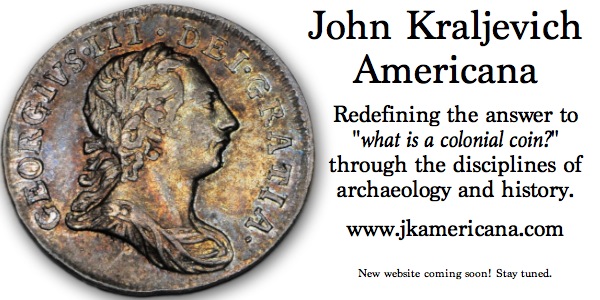
JOHN H. BURNS ESTATE SETTLED

John Burns at his PAN show table (undated photo)
All of John’s possessions have been sold and checks were issued in December to retire his debts. This was no small endeavor, as many of you know. It came to be with a lot of help from the numismatic community.
The final items were sold at the recent PAN Fall Coin show this past October. The liquidation went very well. There was a lot of enthusiasm to view and buy the large variety of material that John collected.
There are some final papers to be filed with the court over the next couple of months to officially close out the estate. To everyone that helped or bought some of the items, please accept our thanks.
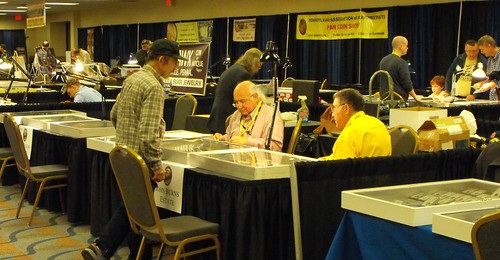
Ed Krivoniak and Don Carlucci selling Burns estate items
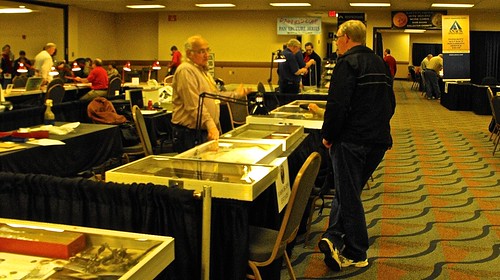
Wayne Homren purchasing Burns estate items
To read the earlier E-Sylum articles, see:
JOHN H. BURNS 1958-2014 (www.coinbooks.org/esylum_v17n02a02.html)
MORE NOTES ON JOHN BURNS (www.coinbooks.org/esylum_v17n03a09.html)
UPDATE ON THE JOHN BURNS ESTATE (www.coinbooks.org/esylum_v17n10a08.html)
JOHN H. BURNS LAID TO REST (www.coinbooks.org/esylum_v17n24a06.html)
NOTES FROM E-SYLUM READERS: FEBRUARY 8, 2015
More on Counterfeit Detection By Biting
Regarding the old practice of biting a coin to see if it's counterfeit, Paul Bosco writes:
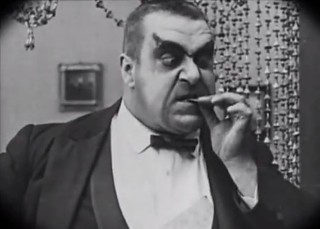 It was only a matter of time before Amos 'n' Andy made into these electronic pages.
It was only a matter of time before Amos 'n' Andy made into these electronic pages.
In a Charlie Chaplin short, the big guy who was Charlie's nemesis, film after film, plays a waiter. Charlie filches a half-dollar tip off a nearby table and presents it to pay his check. The waiter bites the coin, bending it, and then gives it back to Chaplin with a look that promised a beating if a better dime were not forthcoming.
To watch the scene on YouTube, see:
Charlie Chaplin The Immigrant Eric Campbell waiter scene
(/www.youtube.com/watch?v=Ll_dWJGJFXA)
Larry Gaye writes:
I do remember Amos and Andy from childhood. I can still hear Andy saying "Well now, King Fish" in a deep voice. I don't remember seeing him bite the coin but it certainly would be in character. I certainly will check out the video.
Fred Michaelson adds:
At the very end of the Income Tax episode, the Kingfish finds a Morgan Dollar on the sidewalk. That's the good news. The bad is that it distracts him so much that he puts his and Andy's income tax forms into the trash can instead of the mailbox.
To read the earlier E-Sylum article, see:
COUNTERFEIT DETECTION BY BITING (www.coinbooks.org/esylum_v18n05a29.html)
Copper-Plated 1943 Steel Cents
Dave Lange writes:
I was amused by the advertisement for a money-making device, and it reminded me of something else often found in comic book advertising during my youth. One could purchase a "genuine" copper-plated 1943 steel cent just like the ones the U. S. Mint denied ever making. These have been plaguing coin dealers and grading services for generations and will continue to do so for many more years.
Don't forget to bring your magnet...
To read the earlier E-Sylum article, see:
HEY KIDS, WANT TO COUNTERFEIT MONEY? (www.coinbooks.org/esylum_v18n05a30.html)
What is the Highest Value Currency Unit?
David Pickup writes:
I was wondering what the highest value currency unit is. I do not mean the largest denomination e.g. Million Dinars but the value of the unit itself. I looked online and cannot see anything. I think the lowest value is the Iranian currency. Any ideas?
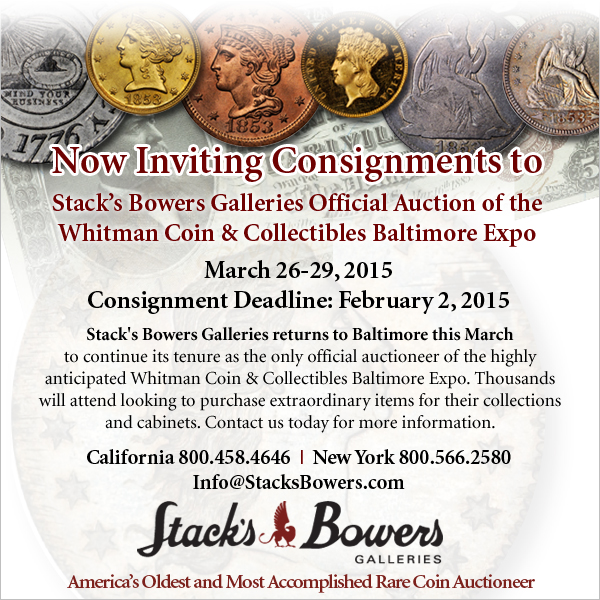
MORE ON ENCASED COINS
Regarding the availability of encased Liberty Head Nickels, Alan V. Weinberg writes:
A well-known fairly accessible encased V nickel is in fact known. It is a usually choice Unc 1908 Liberty nickel in a choice Unc alum encasement for a Portland Oregon bicycle shop. I've owned perhaps 5 of them. Value today perhaps $400.
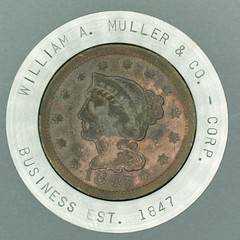
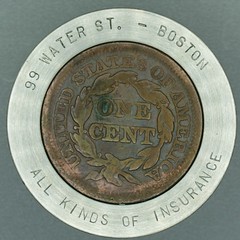
In response to Bob Leonard's comments on the Bakelite encasement;
Dating the manufacture of any encasement of a coin is problematical since the date of the coin in no way is indicative of the date it was encased. Point of fact I own an 1847 Large US cent encased in a stainless steel ring with an engraved message. Pretty sure that it wasn't encased in 1847.
In response to Bruce Smith's comments:
Encased coins are traditionally encased in an aluminum ring or washer. Brass has been used as well. However, I have a stainless steel encasement mentioned above of an 1847 Large Cent. I have encased coins of every US denomination from cent to silver dollar. I have exhibited at the Central States show my exhibit of encased coins, "A Variety of Varieties", which shows different shapes, materials and denominations well beyond the aluminum and brass material and the cents nickels and quarters.


I have a loaf of bread, a maple leaf from Canada and four of the known 14 Teddy Bear shapes. I have an image of a 1911 encased V nickel. "I bring Good Luck / Keep Me and Never Go Broke" on the obv and "Guns, Bicycles and Sporting Goods / Watt Shipp Salem, Oregon " on the rev. The close up shows that the nickel was original as the design overlaps onto the coin. I have a 1948 Dime encased in the shape of Wisconsin with a brass encasement. There are many more unusual shapes and materials out there. Of my roughly 700 plus encased pieces these were the ones to come to mind. Heck I have over 75 pieces with coins encased in Lucite.
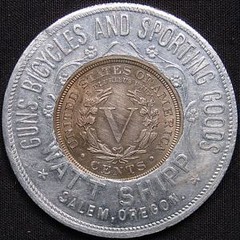
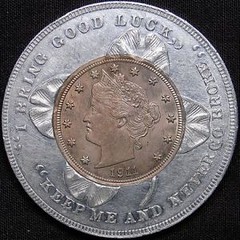
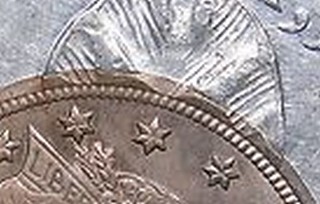
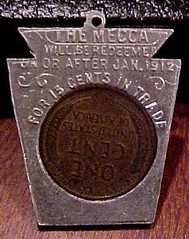

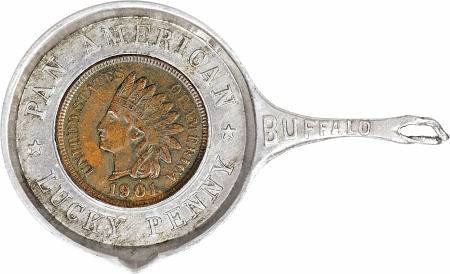
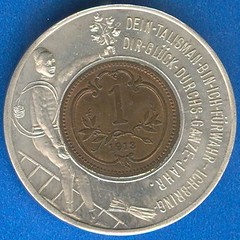
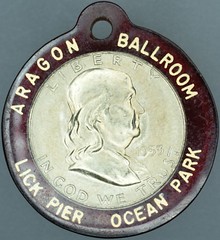
Regarding the bakelite piece - this is a one of a kind hand-made piece. Was it issued? Probably not. Is it valuable? It might be as a curiosity....but I wouldn't bid on it on eBay. I like the Aragon Ballroom piece which is totally encased in plastic. Do you know the significance of Lick Pier and the Aragon Ballroom?
Richard Greever writes:
Regarding the Bakelite encasement… and Bruce Smith's comment about not being aware of liberty nickel encasements, there are several years/varieties of encasements from Salem Oregon. Unfortunately, none are in my collection.

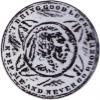
WATT SHIPP / GUNS, BICYCLES AND SPORTING GOODS.
"I BRING GOOD LUCK" / KEEP ME AND NEVER GO BROKE (encased 1913 nickel) TC-55412
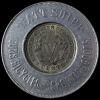

WATT SHIPP / GUNS, BICYCLES AND SPORTING GOODS.
"I BRING GOOD LUCK" / KEEP ME AND NEVER GO BROKE (encased 1906 nickel)
TC-349712

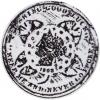
WATT SHIPP / GUNS, BICYCLES AND SPORTING GOODS. / SALEM, ORE.
"I BRING GOOD LUCK" / "KEEP ME AND NEVER GO BROKE" (encased 1903 nickel)
TC-55410
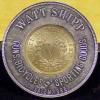
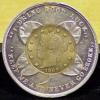
WATT SHIPP / GUNS, BICYCLES AND SPORTING GOODS. / SALEM, ORE.
"I BRING GOOD LUCK" / "KEEP ME AND NEVER GO BROKE" (encased 1908 nickel)
TC-59977
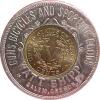
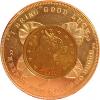
GUNS, BICYCLES AND SPORTING GOODS / WATT SHIPP / SALEM, OREGON
"I BRING GOOD LUCK" / "KEEP ME AND NEVER GO BROKE" (encased 1911 nickel)
TC-51366 *** $471.00 eBay 7/08
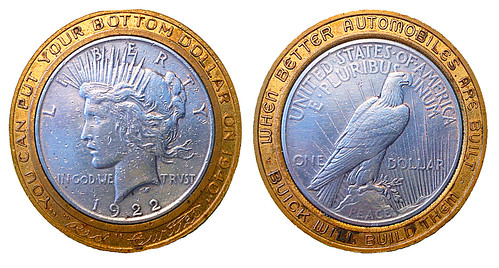
Bob Van Arsdell writes:
Since you've been posting encased items, I thought readers might like to see an encapsulated Peace Dollar. It was issued by Buick in 1940 and is usually thought to be a prize from a sales promotion.
These tend to circulate inside the antique car hobby, so coin collectors may never have seen one. Over the years I've seen four, including one with a Morgan Dollar.
There are also Pontiac money clips with mounted silver dollars; but I've never seen any Chevrolet, Oldsmobile, nor Cadillac items. Thus the promotion involving the encased silver dollars seems not to have been a GM-wide promotion, just one specific to Buick.
The legend includes the name "Red" Custice. This would be Harlow H. Custice, who was promoted to President and General Manager of Buick in 1933. He was promoted to VP of General Motors in 1948.
To read the earlier E-Sylum articles, see:
NOTES FROM E-SYLUM READERS: FEBRUARY 1, 2015 : More on Encased Coins
(www.coinbooks.org/esylum_v18n05a12.html) BAKELITE "MOHAWK" ENCASED LIBERTY
NICKEL (www.coinbooks.org/esylum_v18n04a14.html)
THE FIVE SISTERS BORN 1854 BY DAVID H. COHEN
In 1984, David H. Cohen authored an article in the Liberty Seated Collectors Club (LSCC) Journal titled, “The Five Sisters Born 1854.” Cohen told a great story about a gentleman walking into his friend’s coin store with an album of silver dollars, mostly circulated U.S. Morgan Dollars. At the end of this run of Morgan Dollars there was one page with five 1854 U.S. Liberty Seated Dollars (!). For those of you who don’t know, 1854 Dollars are very rare in all grades, especially as these were “AU to MS-63” grade coins, per David.
Cohen also authored one article in The Asylum (Volume VIII, No. 1, Spring 1990). The article was titled, “Dunham’s easy finding list (pages 17-20).
I am researching the rarity of 1854 Dollars and am looking to get in contact with this David H. Cohen, if possible. If anyone is in contact with David I’d appreciate them forwarding my e-mail contact information to him. I’m also interested in corresponding with anyone who knew him. I can be reached at wdperki@attglobal.net. Thanks.
W. David Perkins Centennial, CO
THE BOOK BAZARRE
FOOD STAMP CHANGE TOKEN RESEARCH UPDATE
Regarding his call for assistance cataloging U.S. Food stamp Change Tokens, Scott Hopkins writes:
Here are the folks who responded to my call and lent a hand: 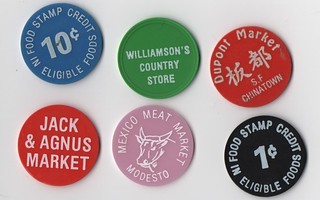
- Mike Florer
- John Ostedndorf
- Don Kolkman
- John and Nancy Wilson
- Pete Smith
- Cindy Wibker
- Jeff Starck
- David Gladfelter
I may have missed someone. But these are the ones who I replied to and answered back, starting a conversation of sorts.
Leon Saryan writes:
In Bruce Smith's excellent notes about food stamp tokens, he states that the paper food stamp coupons of the 1960s to 1990a were "probably" printed at the BEP. I did not think there was any uncertainty on this point. Can you clarify?
I contacted Neil Shafer about this point. He writes:
Bruce Smith last week did an excellent job of presenting the overall picture of food stamps. There are just a few items that I would like to clarify. Food stamps were all uniface, from the stamp images of the 1930s to the end in 2009, regardless of design. The Bureau of Engraving did all the printing until 1971, then American Bank Note was given contracts for portions of the production. All Food Stamp Coupons and Food Coupons were illegal for collectors to hold until late June of 2009.
The 1961 issue of 25c red and $1.00 black Food Stamp Coupons were issued on an experimental basis to a small number of counties considered to be low-income areas. In 1964 the orange 50c and blue $2 were introduced as the Program got underway big time. In 1970 the $5 was introduced. Change for 49c or less was required until March 1975 when the 1, $5 and $10 coupons came out. Then the change requirement went to 99c or less as the $1 could be used as change. A firm in WI called Tropical Lab and Manufacturing Company based I believe in La Crosse was responsible for large thin plastic tokens Bruce referred to.
BEP printed the original food stamps and also the Food Stamp Coupons issued 1961-62. BEP also printed all the Food Coupons without date, then those dated 1967 at first without and later with serial numbers. There were two experimental printings on the Giori press; these were $2 dated 1967-G and $5 coupons dated 1970-G. Both are extremely rare; Amon Carter had the only one I ever saw in a collection; I think it was the $2.
BEP printed 1971-dated Food Coupons as follows: 50c only for high value books, also $2 and $5 for regular consumption as well as the high value books. These higher face value books, introduced early in 1972, were called "household" books; they had special combinations of different denominations in the same book. There were three groups of four such booklets, with face values raised twice as allotments were changed. The first group had face values of $32, $60, $88 and $108; serial prefixes F, G, H, J respectively. Group II had face values of $36, $64, $92 and $112; serial prefixes K, L. M. N respectively. This group was in use from July 1972 to July 1973. Group III had face values of $38, $66, $94 and $116; serial prefixes P, Q, R, S respectively. Group III was phased out in March 1975 when the new designs and denominations were introduced. All coupons from any high value books re extremely scarce to very rare.
American Bank note printings begin with Food Coupons dated 1971A; these were the first made outside the BEP, even though they carry the BEP logo at bottom. Those dated 1973 were also ABN products, and these omit the BEP logo.
To read the earlier E-Sylum articles, see: FOOD STAMP CHANGE TOKEN INFORMATION SOUGH (www.coinbooks.org/esylum_v18n04a06.html) THE HISTORY OF FOOD STAMP CHANGE TOKENS (www.coinbooks.org/esylum_v18n05a11.html)
AUTHOR SEEKS RECOLLECTIONS OF THE FRIEDBERGS
Dave Lange writes:
I've completed the catalog portion of my new book on coin albums published by the Coin & Currency Institute, Inc. These include the Library of Coins and the Treasury of Coins.
At this stage I'm writing the narrative portion of my book. I'm looking for photographs, literature and reminiscences of the Friedbergs, their publishing and their franchising of retail coin shops and departments around the country. I imagine many readers recall the Friedbergs and their employees, as well as perhaps having sold coins to them. If anyone has advertisements or photographs of a department store coin department stocked by the Friedbergs these would be particularly welcome.
David W. Lange
POB 110022
Lakewood Ranch, FL 34211
941-586-8670
http://coincollectingboards.com
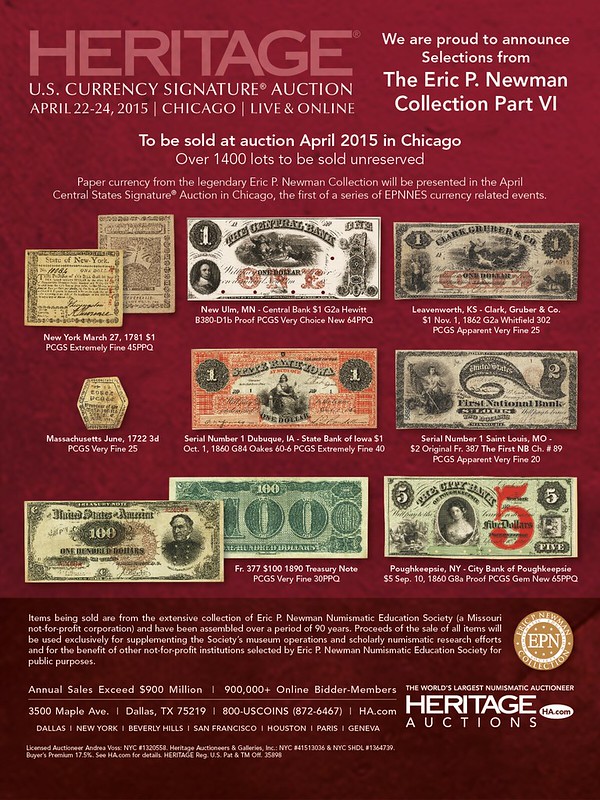
ANA PLANS TOUR OF PROPOSED U.S. MINT SITE AT THE DALLES
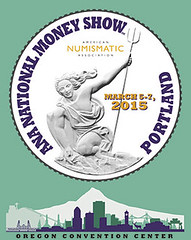 The Pacific Northwest Numismatic Association and the Willamette Coin Club have
arranged a special all-day bus tour of the former proposed U.S. Mint site at The Dalles, Oregon, following the American Numismatic Association's
Portland National Money Show, to be held at the Oregon Convention Center on March 5-7. The tour is scheduled for March 8, the day after National
Money Show closes.
The Pacific Northwest Numismatic Association and the Willamette Coin Club have
arranged a special all-day bus tour of the former proposed U.S. Mint site at The Dalles, Oregon, following the American Numismatic Association's
Portland National Money Show, to be held at the Oregon Convention Center on March 5-7. The tour is scheduled for March 8, the day after National
Money Show closes.
The Dalles, located in Wasco County, was proposed to become a federal mint by Congress in 1864. Wasco was chosen over Portland for its well established federal location with trusted federal officials. The proposed mint was to be an ideal spot for the Gold Rush.
"I stopped to look at The Dalles two years ago and thought 'This is really cool!'" Scott McClaine of PNNA said. "I realized there was a lot of knowledge to be discovered here. There hasn't been a numismatic tour of that building for 15 to 20 years; it is well due."
During construction of the building, Congress halted the project because builders kept leaving to try their luck with gold in the mines, which stopped production of gold sooner than expected. The building was never finished. It is currently being used as a winery.
The tour will leave DoubleTree Hotel in Portland at 8:30 a.m. and return at 6 p.m. Along the way, the bus will stop at the historic Vista House, if weather permits, and Bonneville Lock and Dam in Cascade Locks, Oregon. Registration is $100 per person and includes lunch at The Dalles.
To learn more or to register for the tour, go to the PNNA website at www.pnna.org/ana/toursales.html. For more information, contact info@pnna.org. The Portland National Money Show features more than 500 numismatic dealers with extensive inventories; the ANA Museum Showcase, exhibiting some of the world's most valuable and beautiful coins and paper money; the Collector Exhibits area; and a wide range of educational presentations and seminars. Show hours are 10 a.m. to 5:30 p.m. Thursday, March 5 and Friday, March 6; and 10 a.m. to 4 p.m. Saturday, March 7. ANA members are admitted free. For more information, go to NationalMoneyShow.com.
THE ROYAL MINT'S SMALLEST AND LARGEST COINS GO ON TRIAL
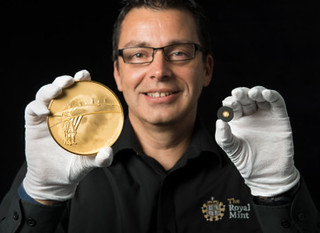 On
February 3, 2015 both the smallest and the largest UK coins ever minted at The Royal Mint are among 70,000 coins on trial at the Trial of the
Pyx.
On
February 3, 2015 both the smallest and the largest UK coins ever minted at The Royal Mint are among 70,000 coins on trial at the Trial of the
Pyx.
Weighing just one fortieth-ounce and measuring a delicate 8mm wide, the coin features a modern interpretation of Britannia. The imposing Kilo coin measures at 100mm wide and continues The Royal Mint’s five-year commemoration of the centenary of the First World War.
The Trial of the Pyx is an ancient annual ceremony and is one of the oldest quality assurance trials in the world. At the Trial, samples of circulating and commemorative coins produced by The Royal Mint over the last year are selected at random and weighed for accuracy.
Now held at Goldsmiths’ Hall, London, the Trial was first recorded publicly in 1282, and is today presided over by the Queen’s Remembrancer or their deputy, who are amongst the highest legal representatives in the country, assisted by an independent jury of Liverymen of the Goldsmiths’ Company.
During the ceremony jury members are presented with Pyx boxes (Pyx being the Roman word for chest). The coins are selected from a random selection provided by The Royal Mint and placed in copper bowls. The remainder are placed in wooden bowls and are then weighed for accuracy. The Trial is then adjourned until May to allow time for trial coins to be tested by Goldsmiths Assay Laboratory and the National Measurement Office.
Whilst modern methods such as XRF (X-Ray Fluorescence) are often used in assaying, it is still only the centuries old methods such as cupellation (the fire assaying of gold) that are accurate enough in the testing of metals and therefore remain credible for checking the accuracy of the coins of the realm for the Trial of the Pyx verdict.
Modern legislation does not mention penalties for an adverse verdict by the Pyx jury, yet there have been stiff punishments for failure in the past. The Master of the Mint (today a role held by the Chancellor of the Exchequer) went to prison for six weeks in 1318 and even Sir Isaac Newton was at loggerheads with the jury during his time as master of the Mint when the integrity of his coin samples was questioned.
To read the complete article, see:
United Kingdom’s smallest and largest coins go on trial
(www.coinsweekly.com/en/News/4?&id=3245)
THE BOOK BAZARRE
FOLLOW-UP ON SEARCH FOR CURRENT WORLD COINS
Jeff Starck of Coin World writes:
In the January 25 edition, Nick Graver inquired about new issues distributors, specifically for two new coins.
The Hungarian Mint does indeed have an official distributor here in the United States, and that is Arthur Friedberg (of the Gold Coin book fame). Art operates the Coin & Currency Institute (www.coin-currency.com), which also distributes coins from Germany’s mints, Belgium and Portugal, among others.
Because of the very focused nature of Hungarian coins, Coin World doesn’t report on them frequently, but when there is a theme of broader appeal we will share stories and direct collectors toward the appropriate distributor.
I am certain that Coin & Currency Institute can satisfy Mr. Graver’s request for the Hungarian coin.
Unfortunately, the Bulgarian Mint and National Bank do not have dedicated distributors here in the U.S., as far as I am aware. They were set up at the World Money Fair last week, though. European distributors or eBay are the most likely sources for that coin.
Best of luck to Mr. Graver on his search!
Nick Graver writes:
Once again, the E-Sylum fraternity has come through with impressive help and amazing speed.
Fellow reader Paul J. Bosco quickly suggested foreign coin specialist Lauren Benson. Richard Benson, of that firm expects to have the Bulgarian piece later in the year. He suggested Arthur L. Friedberg of the Coin & Currency Institute, official distributor of Hungarian issues. Friedberg kindly sent beautiful illustrations of the 2000 Ft piece.
Then E-Sylum reader Dave Hirt wrote from Budapest, offering to go buy the Hungarian coins, which he subsequently did, in both the 10,000 Ft and 2,000 Ft. denominations! Such thoughtful assistance is very much appreciated. We will have several new pieces for our Photographic Numismatic collection and established new friends as well.
Dave Hirt writes:
The coin comes in two denominations : 10,000Ft in .925 silver, proof, and 2000Ft in copper-nickel, BU. I got a set for Nick and liked them so much, I bought a set for myself. The Budapest mint puts out some very nice products.
To read the earlier E-Sylum article, see:
NOTES FROM E-SYLUM READERS: JANUARY 25, 2015 : Dealer in Current World Coins Sought
(www.coinbooks.org/esylum_v18n04a09.html)
2015 MEDAL COLLECTORS OF AMERICA MEDAL
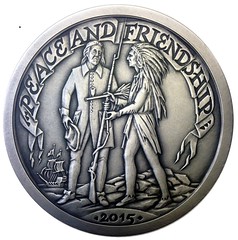
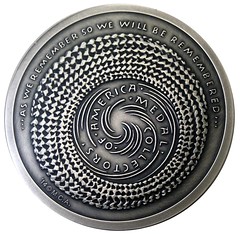
The Medal Collectors of America are pleased to announce the release of their 2015 club medal. Designed by the legendary Alex Shagin. Available in a 5 oz silver version for $250 and bronze for $45, orders must be received by April 1, 2015.
Please note that they are only available to MCA members. Dues are $55/year and include mailed hard copies of MCA Advisory [6 issues per year]; $25 (Includes subscription of electronic online copies of MCA Advisory). Joining is easy; send an additional payment for the medal with your order to join. For more information see: www.medalcollectors.org
Please send your check or money order to:
MCA c/o Barry Tayman
3115 Nestling pine Court
Ellicott City, MD 21042
History is Always Right
Alex Shagin
Among the most elegant pairs of sandals parked by the entrance to the Temple of Apollo, there was one that almost certainly belonged to the celator’s Muse. No records survive as to an Academy voting on the likeness of the Nymph Aretusa – the one done by Kimon or that by Eautanetos. Today, we simply enjoy them both.
When, come the Renaissance, the noble art of medal-making had been resurrected, there still was no “Academy Award Night” to choose between Antonio (of Pisa) and Benvenuto ( of the Cellini family) and many others toiling in their shops to outdo the ancients. When the first steam engines arrived in the 19th century, the art of die-sinking had spread all over Europe. These machines enabled the art of the “mini-monuments” that could be passed from hand to hand and left well rested in the safety of cabinet drawers, or passed from grandfathers to grandchildren as cherished heirlooms.
Between Pistrucchi, Wyon and Dupre, there was no bitter rivalry nor Academy Awards at which to aim. The patrons of the arts were just doing what felt right. The “king of hobbies” craved no prime television time, because the celator’s Muse preferred to work hand in hand with Clio, the Historian, and stayed away from the executives in Central Casting.
Just a short time later came the era of the “Peace and Friendship” medals that got a great deal of recognition and support on both sides of the Atlantic. Native chiefs were proud of these coveted trophies, seeking to show them off even on their way to places of eternal rest. That glorious tradition celebrating the diplomatic ties between the European powers and First Peoples has left modern day scholars with some of the greatest examples of numismatic art – art that served to immortalize.
These medals are pieces of our cultural history that have kept civilization on the march (and connoisseurs on their toes). As memorials, they continue to educate and entertain and inspire. This, then, is what the 2015 MCA Club medal is seeking to re-enact, doing so without a big budget, wide screen theatres or Hollywood searchlights. Our medal focuses on some of the golden moments of history, with the aim to appeal to patrons of art and craftsmanship. Our hobby has been “the privilege of few and the envy of many” for over 25 centuries.
So many faithful practitioners and generous supporters have worked for so long to preserve this cultural celebration of the creative spirit and the progress of the human race that it feels almost too easy for us today to fill those “sandals” and follow the footsteps of the old masters in our attempt to deliver the “message” and to share the “stage” with all people of good will. Yet, as in so many instances of turbulent eras in the past, we are still finding our culture at the crossroads (and in the cross-hairs) of the conflicting agendas and demands being presented to our small group of enthusiasts as well as modern day society as a whole.
Your recognition of the message encoded in this new design (“AS WE REMEMBER, SO WE WILL BE REMEMBERED”) will be crucial for the future of an “authors-generated” art and its ability to contribute to the well-being of the medium. This we say even as we witness the ongoing process of revision and “modernization”; ours is like the basketry craft competing with plastic containers.
Before we are history let us remember Abe Lincoln’s immortal words, “We cannot escape history”. Thus, history is going to remain the most demanding judge and jury. I give you this medal not expecting awards or fanfare, just your simple enjoyment of what the art can produce.

HARVEY STACK ON THE COLLECTIONS OF REED HAWN

Reed Hawn, a Texas oilman and Arabian horse breeder, became known to the collecting world during the last quarter of the 20th century. He started collecting coins from change when he was nine years old, placing them in a coin album. He learned about rarity and quality from handling coins and reading all he could about them.
In 1961 at the age of 12, he and his family traveled to New York from Austin, Texas. Reed visited Stack's and began his deep involvement in collecting rare and choice coins, initially with the help of his father, Bill Hawn, who felt that a hobby could offer education and possible investment for his young son.
By the time Reed reach age 24, he had assembled an outstanding collection of United States coins, with a specialty in half dollars. That collection was sold by Stack's in New York in 1973, attracting collectors and buyers from all over the United States. Reed recalled in a later interview that the scope and quality of the coins he had assembled led to a standing room only auction venue, where it was difficult to get through the doors. Record prices were bid, large gains in value were attained, and Reed felt his connoisseurship, following guidance from the Stack family, led to the success of the sale.
His long time desire, even at the age of 24, was to own two coins heralded as "keys" to the American series. Shortly after the sale of his collection in 1973, he purchased the famous Mickley 1804 Class I silver dollar for $150,000 in a private sale from Stack’s. At the time this was a record price for any coin sold at auction or by private treaty. That coin is known today as the Mickley-Hawn Class I 1804 silver dollar.
The other prize he always wanted to own was a 1913 Liberty Head nickel, heralded during the 20th century as a great rarity. People were urged by coin dealers to "check their change daily" to find one. At one time, Col. E.H.R. Green owned all five known pieces, but most people never had the chance to own even one. However, the challenge of looking opened the field of coin collecting to many. During the Jerry Buss Collection sale in the late 1980s, the 1913 was offered and Reed bought it. Now he owned both his dream coins!
From the time he sold his first collection in 1973 until he decided he needed to sell the second in 1993 Reed traded other series of U.S. coins, from the cent to the double eagle. He sought the highest quality he could find and gathered some great rarities when they became available in the market. Many "finest knowns" were part of his holdings. His knowledge and connoisseurship continued to grow.
Reed Hawn’s great knowledge of numismatics, and his financial and monetary background led to his acting as advisor to Senator Lloyd Bentsen of Texas, for monetary and coinage matters. Later Reed was nominated and served for over a decade on both the Citizen’s Commemorative Advisory Committee for Congress and the U.S. Mint, and the Citizen’s Coinage Advisory Committee. When Lloyd Bentsen served as President Clinton's First Secretary of the Treasury, Reed worked with the Treasury as he did during his time on the Advisory Committees.
While on the committees, he and Kenneth Bressett, a prominent numismatist, author and past president of the American Numismatic Association, argued with Mint officials and other members of the Advisory committee, about the large quantity of special coins being struck and the profit being made by the Mint. But they were unable to get the Mint to see the collectors’ point of view. Many new collectors left the hobby, as keeping up with the many Mint products was nearly impossible and losses were sustained by many who purchased them.
Reed Hawn developed a keen knowledge of the way Washington works and the way the Mint functions. Because of this and his background in numismatics and monetary matters, he was asked if he would consider the position of Mint director when candidates were being submitted to the Obama Administration in 2009,
When asked if he would consider the job, he said the of course he would. He felt he had the necessary background having worked so long with the Mint advisory committee, his relations with Lloyd Bentsen's office, and his numismatic background.
When asked what he would he do as director, Reed responded that he would first listen and review what was done in the past. He would then make suggestions and take actions to improve the performance of the Mint. He would also address the ways coins were handled and sold by the Mint, which had resulted in citizen complaints about the high profits and overproduction of many Mint commemorative issues. He also noted that as a collector he knew what motivated individuals to collect and save. He felt that the Mint could improve how it treated collectors and that he would concentrate on that. As collectors supported the Mint through their purchase of commemorative products and coins with special finishes or strikings, Reed believed: "You got to treat them right!"
Reed Hawn’s collecting background and personal dedication to what collectors want and need inspires him to be an advocate for the collector, young and old. I personally believe that the next director of the Mint should be a current or past coin collector who understands what supply and demand does for a hobby. If he is still available when the job opens again, I would be the first the recommend and endorse the nomination of Reed Hawn.
To read the complete article, see:
The
Incredible Collections of Reed Hawn, Part 10 (www.stacksbowers.com/NewsMedia/Blogs/TabId/780/ArtMID
/2678/ArticleID/64963/The-Incredible-Collections-of-Reed-Hawn-Part--10.aspx)
PENNIES CHANGED THE COLOR OF A HOT SPRING
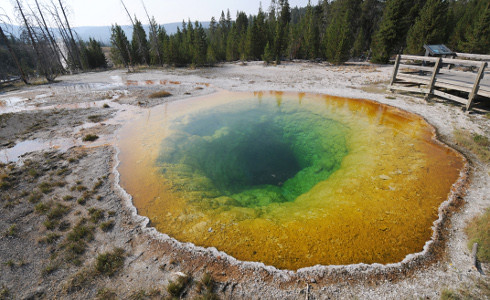
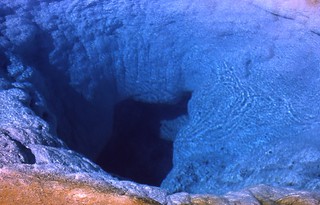 Yellowstone National Park's Morning Glory thermal spring used to be deep blue but its current
yellow and green hues were caused in part by tourists throwing coins, rocks, and assorted crap into the pool. The detritus has the effect of
"partially blocking the underground heat source and lowering the temperature of the spring to a range habitable by photosynthetic microorganisms
that probably didn’t live there before" and produce pigments that result in the yellow and green color, according to a Science Friday article.
The image at right is from 1966
Yellowstone National Park's Morning Glory thermal spring used to be deep blue but its current
yellow and green hues were caused in part by tourists throwing coins, rocks, and assorted crap into the pool. The detritus has the effect of
"partially blocking the underground heat source and lowering the temperature of the spring to a range habitable by photosynthetic microorganisms
that probably didn’t live there before" and produce pigments that result in the yellow and green color, according to a Science Friday article.
The image at right is from 1966
To read the complete article, see:
People throwing pennies changed the color of a Yellowstone hot
spring (http://boingboing.net/2015/02/06/people-throwing-pennies-change.html)
To read the original Science Friday article, see:
Picture of the Week: Yellowstone’s Morning
Glory (http://sciencefriday.com/blogs/02/04/2015/picture-of-the-week-yellowstone-s-morning-glory.html)
THE BOOK BAZARRE
CUBA UNVEILS LARGE DENOMINATION BANKNOTES
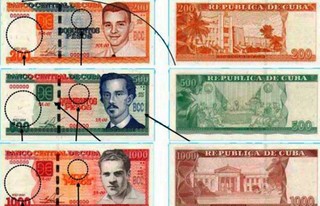 The
Cuban largest denomination bills, of 200, 500 and 1000 Cuban pesos began circulating on Sunday in the country, in order to facilitate transactions in
that currency (CUP) in dollar stores (TRD) as announced by the Central Bank of Cuba (BCC).
The
Cuban largest denomination bills, of 200, 500 and 1000 Cuban pesos began circulating on Sunday in the country, in order to facilitate transactions in
that currency (CUP) in dollar stores (TRD) as announced by the Central Bank of Cuba (BCC).
Backed by Resolution No. 4 of January 15, 2015, and published on the same date in the Gazette Extraordinary No. 3, the measure seeks to streamline operations and reduce risk levels by avoiding the use of large amounts of money in low denomination bills.
Francisco Mayobre Lence, vice president of BCC, recently told reporters that the new notes would be put in circulation on February first but gradually, through entities Banco Metropolitano, People's Savings Bank, the Bank of Credit and Trade and the Exchange Houses, known as CADECAs.
He clarified that by now they will prioritize Havana, provincial capitals and some municipalities, which is in line with the level of operations that has manifested in certain places.
He emphasized on the need for people to learn to identify the new banknotes, which among its security measures have two watermarks, one with the image of Celia Sánchez; the number that corresponds to them; the security thread; embossed printing, and the initials of the BCC.
With predominance of orange, the 200 peso banknote has the image of patriot Frank País and in the back an allegory of the School City July 26, and in the 500, in which prevails the green color, has the bust of Ignacio Agramonte, and on the back a painting of the Constituent Assembly of Guáimaro.
The 1000 peso banknote is brown, with the figure of Julio Antonio Mella and a graphic composition of the University of Havana.
To read the complete article, see:
Large Denomination Bills Begin to Circulate in
Cuba (www.cubanews.ain.cu/economy/2399-large-denomination-bills-begin-to-circulate-in-cuba)
THE BOOK BAZARRE
TEXAS MAN PAYS TAXES IN FOLDED DOLLAR BILLS
A Wichita Falls man made news last week when he was arrested while trying to pay his property taxes.
Only there’s a little bit more to the story than that. The 27-year old Texan, Timothy Andrew Norris, arrived in person at the Wichita County Courthouse to pay his $600 property tax with individual dollar bills – only there was a twist. Or, er, a fold. Norris had allegedly folded each bill so tightly that it “required tax office personnel approximately six minutes to unfold each bill.”
If you’re doing the math, that means that it would take 3,600 minutes – or 60 hours, longer than a work week – to unfold the bills.
Tax Assessor Collector Tommy Smyth said that the spectacle brought work in the office to a halt so he asked Norris to leave. Norris refused and was eventually arrested and charged with criminal trespass. As you can imagine, Norris was none too happy about being arrested and attempted to break away from the arresting officer, earning him an additional charge of resisting arrest.
Texas makes it clear that cash is an acceptable form of payment for property taxes. At Section 31.06 of the Texas Code:
A collector shall accept United States currency or a check or money order in payment of taxes and shall accept payment by credit card or electronic funds transfer.
The same is true for the feds. There is no law that says you have to pay your taxes by check, credit card or by using the largest bills possible. By federal law, at Section 31 U.S.C. 5103, you can pay your taxes in coins and currency:
United States coins and currency (including Federal reserve notes and circulating notes of Federal reserve banks and national banks) are legal tender for all debts, public charges, taxes, and dues.
You may not want to try this at home. When you pay your taxes in cash, you’ll need proof of payment, which means you need a receipt. If you make it difficult for your payment to be counted, you might not get that receipt. The tax office isn’t staying open extra hours to count your money – nor do they have an obligation to do so. I’m guessing that you could make the argument that the tax office is required to count your cash every day until they have a total (and therefore a receipt) for you. In the case of Mr. Norris, assuming that they put a staffer on unfolding and counting his cash payment every day, it would take over a week to process, likely making Mr. Norris’ tax payment late.
Of course, we weren’t in the tax assessor’s office that day but I’m guessing Norris didn’t offer to come back the next day. Again, we don’t know what happened exactly. We just know it didn’t end well.
To read the complete article, see:
Texas Man Arrested
After Attempt To Pay Taxes With Dollar Bills
(www.forbes.com/sites/kellyphillipserb/2015/02/03/texas-man-arrested-after-attempt-to-pay-taxes-with-dollar-bills/)

FEATURED WEB PAGE: THE BLACK CABINET
This week's Featured Web Page is the Black Cabinet, an online database of counterfeit American coinage currently in circulation. Thanks to Larry Dziubek for a tip that led me here.When coin collectors have a collection of counterfeit coins for their own personal reference, such a collection is generally known as a “black cabinet.” Likewise, The Black Cabinet is a database and reference library of counterfeit American coinage currently in circulation. Its purpose is to educate coin collectors and the general public about counterfeits and their impact upon the hobby.

www.theblackcabinet.org
